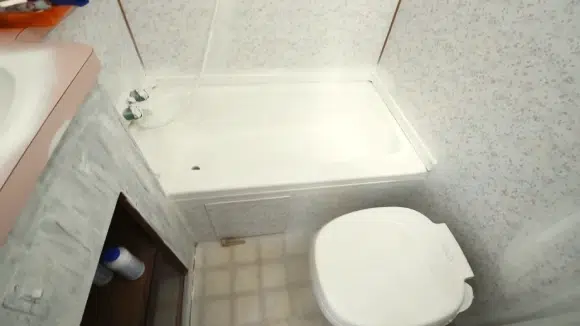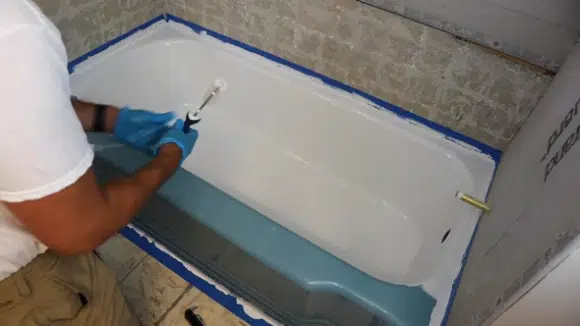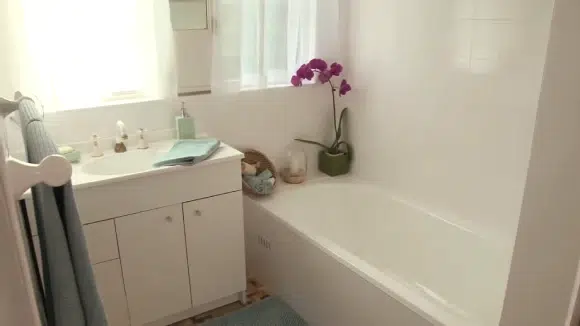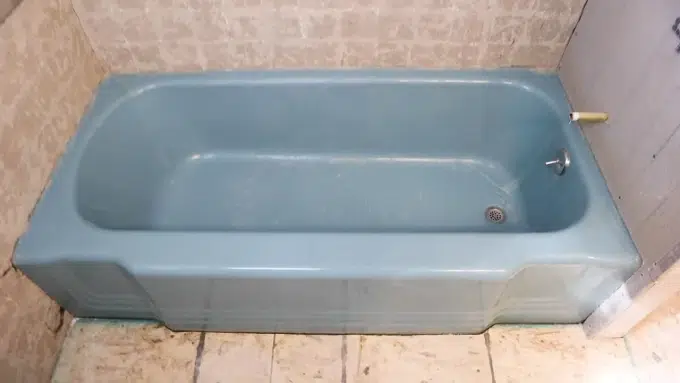Last Updated on April 11, 2023
Updating an RV bathroom can be a daunting task. Painting an RV bathtub is no exception. Taking the time to clean, prep, and paint your tub correctly will ensure you get a beautiful finish that lasts for years.
Here, we’ll cover everything you need about painting your RV bathtub on a budget. We’ll go over preparation steps like cleaning the tub and removing old caulk and tips on applying the paint evenly and drying correctly.
And finally, we’ll discuss aftercare and maintenance tips to keep your newly painted bathtub looking great for longer. Read on for all the details.
How Can You Paint an RV Bathtub: Easy Steps

With a few simple steps, you can touch up the paint job of your tub and create an eye-catching feature for your RV. Below are some guidelines to help you achieve a professional-looking finish when painting your tub.
Preparation
Painting an RV bathtub can be an effective way to revive the look of your RV, giving it a new sense of life. It takes some preparation and effort, but you can achieve great results with the right steps. Let’s discuss the process in more detail.
Cleaning the Tub:
The first step towards painting your RV bathtub is cleaning it thoroughly. This involves using soap and warm water to remove any dirt and grime that may have accumulated on the surface.
After this, you’ll want to let it sit for at least an hour before rinsing off all the soap and wiping down the tub with a clean cloth.
Removing Old Caulking:
Before refinishing an RV bathtub, old caulking should be removed to ensure a clean, even finish when you’re done.
You can use a utility knife or razor blade to scrape away any existing caulk around the edges of your bathtub, followed by using mineral spirits or acetone to remove any residue left behind. Wear gloves when handling these substances, as they can be quite harsh on your skin.
Selecting the Right Paint
When painting an RV bathtub, the best paint is high-quality epoxy paint. This type of paint provides excellent protection against heat and moisture, making it ideal for use in bathrooms.
Additionally, epoxy paint is more resistant to scratching and corrosion than other types of paint, making it a great choice for long-term protection and durability. When selecting an epoxy paint for your RV bathtub, look for one that offers anti-fouling properties and UV protection, as this will help keep your tub looking its best for years to come.
Choosing the Right Spray Paint or Resin
When choosing spray paint or resin for an RV bathtub, you’ll want to opt for something that provides good coverage and excellent adhesion capabilities.
A two-part epoxy primer and topcoat combination is usually recommended, providing maximum adhesion and great protection from moisture and heat.
Consider adding a sealer on top of the primer/topcoat combination to protect your RV tub from further scratches or fading.
Application of Paint or Epoxy
Use a brush or roller specifically for applying these substances for best results when applying your chosen epoxy or resin.
Be sure to follow all instructions carefully when mixing together the resin or epoxy with its accompanying hardener; doing so will ensure optimal performance and longevity of the product on your RV bathtub.
Always allow time between coats so that each layer can fully dry before applying another coat; this will help ensure even coverage without any lumps or bumps in the finish. Allow at least two hours between coats before continuing with additional layers if necessary.
Applying Multiple Coats
If you’re going for a glossy finish on your RV bathtub, then multiple thin coats are definitely recommended to achieve this effect. Begin by sanding any imperfections on the tub’s surface with fine sandpaper before starting with the first paint/resin/epoxy coat.
After allowing sufficient drying time (at least two hours), apply subsequent thin coats until you have achieved your desired level of glossiness in the finish. Though more time-consuming than applying one thicker layer, taking care when building up several thin coats is well worth achieving an eye-catching result.
Drying Time
As mentioned, you must allow adequate drying time between each stage when painting an RV bathtub (or any other surface).
The amount of time required between each coat will depend on both environmental factors (such as temperature) as well as what type of product was used during application; typically, though, most products require around 8 hours before they are fully cured and ready for use again (though always check manufacturer’s instructions first).
If using multiple layers, take extra care when allowing them enough drying time failure to do so could cause cracking down the line if further layers are added too soon.
Techniques for Painting Fiberglass Correctly
When painting fiberglass correctly, certain techniques should be employed to get a professional quality result every time.
Start by thoroughly cleaning off all dirt and debris from the fiberglass surface before beginning with any primers or paints; warm soapy water typically does the job nicely here. However, follow manufacturers’ instructions carefully if using specialist cleaning products.
Then use sandpaper (preferably 200 grit) to abrade away any imperfections lightly, such as cracks that might otherwise cause problems once coated over; doing so ensures a smooth surface where a primer can properly adhere later on.
Finally, begin coating key areas such as corners first, then sweeping brush strokes across each section until fully covered. Remember that thinner layers are better than fewer thicker ones here, so aim for build-up with several light coats rather than just one thick layer.
Finishing the Job

Finalize your RV bathtub makeover to ensure it looks brand new. After sanding, priming, and painting, you’ll want your project to last. Finish the job with caulking and decorative accents, if desired. To finish this job, read on.
Adding New Caulking Around Edges Of Tub:
Once all layers of paint have dried thoroughly, apply a bead of caulk along all edges where two surfaces meet (such as where tile meets metal). This will help protect against water damage and give you a complete look when all is said and done.
Obtaining A Finished Look With DIY Project:
Finally, get creative with your finished project – add stencils or decorative accents if desired – you can customize it in many ways.
Common Problems and How to Avoid Them
Knowing common problems that may arise during painting properly is essential to ensure success on this DIY project. Here are a few common mistakes and tips on how to avoid them:
Paint Peeling Off
Paint peeling off an RV bathtub is a common problem caused by several factors. One potential cause is improperly prepping the surface before painting, such as ensuring that all dirt and debris are removed before applying a primer or paint. If the surface was oily or wet, this could also prevent the paint from adhering correctly.
In addition, using low-quality paint could result in premature peeling. To avoid these issues, it is recommended to use good-quality paint specifically made for fiberglass surfaces and follow manufacturer instructions for preparing and applying the product.
Uneven Surface
An uneven surface on an RV bathtub can occur if the primer or paint is not evenly applied when painting. Additionally, it could happen if there were inconsistencies in the texture of the surface due to dirt, debris, or other contaminants being left on the tub before painting.
To avoid this problem, remove any dirt and debris from the tub before beginning any painting project. Practice even strokes when applying primer and paint to ensure an even coating throughout the area.
Discoloration
Discoloration of an RV bathtub is typically caused by exposure to sunlight over time or by using a type of paint that contains harmful chemicals which react with sunlight.
To prevent discoloration, select a high-quality paint designed for use on fiberglass surfaces that do not contain harmful agents and limit prolonged exposure to direct sunlight on painted areas after finishing your painting project.
Result of Not Painting Fiberglass Correctly
When not painting fiberglass correctly, you may run into problems such as peeling, bubbling, cracking, fading colors over time, and poor adhesion of paint materials due to improper surface preparation before painting or not selecting quality products designed for fiberglass surfaces.
To avoid these issues, it is essential to properly prepare any fiberglass surface before beginning your project with cleaning materials designed for fiberglass surfaces, such as mineral spirits and acetone.
Then select products specifically made for fiberglass projects, such as primers and paints, and apply multiple thin coats when possible, following manufacturer instructions to achieve optimal results with your project.
Importance of Extensive Research Before Starting the Project
Before starting any painting project involving an RV bathtub, it is important to do extensive research about different types of paints specifically made specifically after fiberglass as well as how best to prepare a particular surface before beginning painting so that you can achieve optimal results.
Additionally, researching proper methods for application, such as adding thin layers vs thick layers, will help ensure quality results from this DIY task.
After Care & Maintenance Tips For Your Painted RV Bathtub

Caring for your freshly painted RV bathtub is essential to maintaining its condition. To ensure the longevity and durability of your paint job, it’s essential to be mindful of how you clean and maintain the surface. Here are a few tips for taking care of your painted RV tub.
Avoid Scrubbing or Scrubbing Pads:
When cleaning your freshly painted surface, it’s essential not to use rough scrubbing pads or materials, as this can wear away the paint over time. Instead, use a microfiber cloth with warm water and avoid harsh detergents, chemicals, or abrasives.
Wipe Down Surfaces Regularly:
To keep your freshly painted surfaces looking their best, it’s important to wipe them down regularly with a soft microfiber cloth and warm water. This will help to remove any dirt, grime, or soap residue that may have built up over time. Avoid using strong detergents as much as possible, as these can strip away the shine from your newly painted surfaces.
Wax Your Newly Painted Shower Every Six Months:
Waxing annually is recommended to protect your newly-painted shower from weathering, sun damage, and discoloration caused by harsh soaps. This will help create a protective layer between the paint and other elements, ensuring its color remains vibrant.
Can I Paint My Bathtub Myself?
You can paint your bathtub yourself. First, make sure to remove any old caulk and hardware, and then clean it with cleaning products like diluted bleach or scrub cleansers. Also, open a window for good air circulation.
Pick the right kind of paint. Acrylic polymer paints are best for an acrylic bath, and epoxy paint is best for cast iron tubs. Once you have chosen your paint, apply a foam roller, brush, or sprayer. Take your time and be careful with even strokes. Let the paint dry completely before using the tub again.
Is Painting a Bathtub a Good Idea?
Painting your bathtub is a great way to update and transform your bathroom without spending a lot. It’s not an easy project, so you must be patient and pay attention to detail. Ensure you have all the materials, like primer, paint, and other supplies.
It would be best to use epoxy paint made for tubs and tiles to last longer in hot or damp conditions. Clean the surface of your bathtub with detergent or degreaser first before applying primer and letting it dry completely. Then carefully apply the paint as directed on its label, so it doesn’t crack or peel off over time.
To make your painted bathtub last longer than just a few years, consider adding a sealant after painting which will help protect it from water damage and discoloration. With these steps in mind, painting your bathtub can be an easy way to add an updated look without breaking the bank.
What is the lifespan of a tub that has been painted?
Painting a bathtub allows you to give your bathroom a new look without spending too much money. Depending on your paint, it can last 5-10 years. Before painting, clean the tub with an abrasive cleaner and sandpaper to make sure the paint sticks well.
Then, let an oil-based primer dry for metal before applying two coats of Rustoleum Tub and Tile Paint. Ensure you follow all instructions the manufacturer provides for drying time, so your paint has enough time to cure properly after painting.
Does Bathtub Paint Peel?
Bathtub paint can peel for many different reasons. Sometimes it’s because the tub wasn’t cleaned before painting, or maybe the wrong paint was used. It could also be caused by things like old chemicals or cleaning products or because it’s getting old.
You must get some materials and clean the area first to fix it. You should also remove a spout if there is one. Then spray with a light coat of acrylic urethane enamel from a can, or use epoxy to fill in chips and cracks in the surface.
If the bathtub finish is flaking off, it wasn’t appropriately refinished before and should last 10-15+ years when done correctly. Take care of the peeling paint immediately, so it doesn’t worsen.
Transform Your RV Bathtub with a Fresh Coat of Paint
After following these steps, you can enjoy your newly painted RV bathtub as long as you live. To maintain the pristine look of your newly painted surface, clean it regularly with a warm damp microfiber cloth and wax it every six months.
With careful preparation and using the right materials, it is an easy and affordable way to get the updated look you want in no time.



